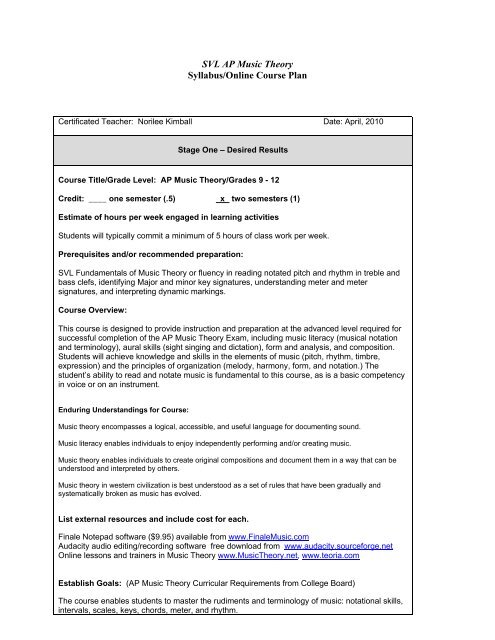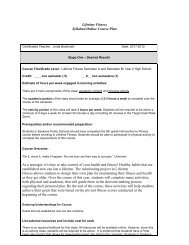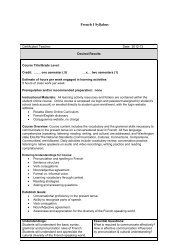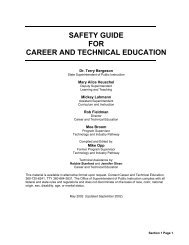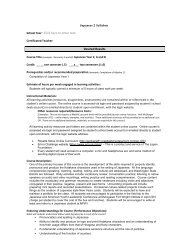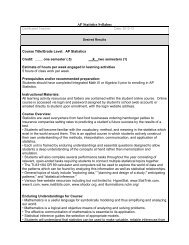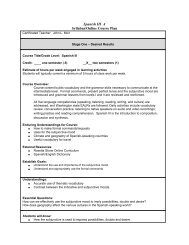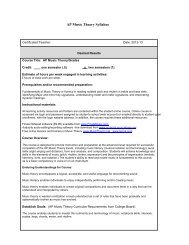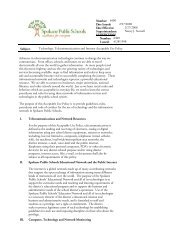SVL AP Music Theory Syllabus/Online Course Plan
SVL AP Music Theory Syllabus/Online Course Plan
SVL AP Music Theory Syllabus/Online Course Plan
You also want an ePaper? Increase the reach of your titles
YUMPU automatically turns print PDFs into web optimized ePapers that Google loves.
Knowledge:Notation of pitch-the staff rhythmic notationMeter signaturesSimple versus compound metersDynamic markingsSkills:Extremely fluent recognition of note names in treble and bass clefSight reading rhythmsAurally recognizing errors in rhythmic notationNotating manuscript appropriately according to set guidelinesAssignments/Assessments:Students will review this knowledge or acquire greater fluency with this knowledge by using an online resourcewith built-in theory and aural skill trainers.UNIT 1: SCALES, TONALITY, KEYS, MODESKnowledge:Major and minor scalesTonalityKeySkills:Reading and writing major and minor scalesReading and writing key signaturesAural recognition of major and minor scalesSight singing major and minor scalesAssignments/Assessments:Written assignments will give students practice in recognizing and writing key signatures and scales.Students will participate in an ongoing virtual discussion via a bulletin board on the properties and extendeduses of the Circle of Fifths.Ear training begins with melodic dictation assignments.UNIT 2: INTERVALS AND TRANSPOSITIONKnowledge:Perfect, major, and minor intervalsAugmented and diminished intervalsTranspositionMethods of transpositionSkills:Writing intervals with fluencyHearing intervals with fluencySight singing intervalsWriting transpositionsAssignments/Assessments:Both written and aural exercises will drill students in their ability to hear and write all intervals.Ear training continues with interval drills and with sight singing quizzes via telephone.UNIT 3: CHORDS
Knowledge:Major, minor, diminished and augmented triadsSeventh chordsTriads on scale tonesTriad inversionRoman numeral chord symbolsFigured bassPopular music symbolsSkills:Identifying all four triad typesWriting all four triad typesAural identification of all four triad typesAnalyzing chord progressions using Roman numeralsAnalyzing chord progressions using figured bass symbolsWriting chord progressions using popular music symbolsAssignments/Assessments:Students will practice correctly spelling triads via written assignments.Written assignments will give students opportunity to practice writing correctly spelled chord progressions fromboth Roman numerals and figured bass symbols. Additionally, students will analyze given chord progressionsusing Roman numerals or figured bass symbols.Harmonic dictation extends students' aural skills in this unit.As both an ear training exercise and to reinforce popular music symbols, each student will create their own leadsheet of a song of his or her own choosing, including melody and accompanying chord symbols.UNIT 4: CADENCES AND NONHARMONIC TONESKnowledge:PhraseCadence typesNon-harmonic tonesSkills:Recognizing cadence types on paperAural recognition of cadence typesAnalyzing chord progressions including non-harmonic tonesAssignments/Assessments:Written assignments will give students opportunity to develop their skills in writing phrases, recognizing cadencetypes and identifying non-harmonic tones.UNIT 5: SPECIES COUNTERPOINT AND 4-PART VOICE LEADINGKnowledge:The first four species of counterpointVoice leading in four-voice textureCommon chord progressionsSkills:Writing first, second, third and fourth species counterpoint with appropriate voice leadingFour-voice realization of Roman numeral chord symbolsFour-voice realization of figured bass symbols
UNIT 8: MELODIC ORGANIZATIONKnowledge:The motiveThe sequencePhraseMelodic structureSkills:Composition of motivic piecesComposition of sequencesFormal analysis of written and aural examples containing motives, sequences Composition of melodyAssignments/Assessments:Students will find their own example of a melody with good structure and defend their choice.They will also compose a brief melody with a sequence and a melody with a motive.As a culminating project for the unit, each student will compose a larger piece which demonstrates goodmelodic structure and either a motive OR a sequence.Melodic dictation becomes quite complex with no limit to intervallic skips, rhythms or mode.UNIT 9: TEXTUREKnowledge:Overview of music historyTextureTexture typesSkills:Analysis of texture from both written and aural examplesComposition of pieces containing various texture typesAssignments/Assessments:To give texture types a context, students will learn about the period of Western musical history in which eachtexture type was most prevalent. To gain more depth of knowledge of each period, students will do researchand write brief essays on given characteristics of the period (i.e., word painting in polyphonic music of theRenaissance.)As a culminating project for the unit, students will find a piece that demonstrates each of the given texture typesand write an in-depth analytical essay defending their choice of representative piece.UNIT 10: FORMAL ANALYSISKnowledge:Formal divisionsOpen versus closed formal divisionsOverview of 20 th century musicSkills:Analysis of form from both written and aural examplesComposition of a binary piece and a ternary pieceAssignments/Assessments:As a culminating assignment for this unit, students will write a piece which must follow a given form. They mustalso write in a given texture type.
UNIT 11: <strong>AP</strong> EXAM REVIEW AND PRACTICEKnowledge:The four parts of the <strong>AP</strong> Exam and the types of questions contained in eachStrategies for maximizing your score on the <strong>AP</strong> ExamAssignments/Assessments:Students will take the released 2003 exam section by section after having learned about the content andstrategies relevant to that section. This serves as a review for the exam and as a course final.Direct Instructionx__Structured Overviewx__Mini presentationx__Drill & Practice____Demonstrations____Other (List)IndirectInstructionx__Problem-based___Case Studiesx__Inquiryx__ReflectivePracticex__Projectx__Paper____ConceptMapping____Other (List)ExperientialLearning____ Virt. FieldTrip____Experiments____Simulations____Games____FieldObserv.___Role-playing____Model Bldg.____Surveys____Other (List)Independent Studyx__Essaysx_Self-pacedcomputer____Journalsx__Learning Logsx__Reportsx__Directed Studyx__Research Projects____Other (List)InteractiveInstructionx__Discussion____Debates___Role Playing____Panels____Peer PartnerLearning____Project team____Laboratory Groups____Think, Pair, Share____CooperativeLearning____Tutorial Groups____Interviewingx__Conferencing____Other (List)Scope and Sequence:Week Unit Lessons Due1 1 Introductory Tasks21Scales, tonalitykeys, modes3 14 152Intervals andtransposition1.01 Major Scales1.02 Key Signatures and the Circle of Fifths1.03 Building Key Signatures1.04 Natural minor and relative keys1.05 Three types of minor scales1.06 Hearing Major and minor scales2.01 Introduction to Solfege: a system for sightsinging2.02 Writing and hearing Major and minor 2nds2.03 Writing and hearing Major and minor 3rds1.01a - b1.02a - b1.031.04a - b1.05a - b1.062.012.02a - b2.03a - b6 22.04 Perfect Intervals: unisons octaves, 4ths, and 5ths2.05 Writing and hearing Augmented, and diminished4ths and 5ths2.042.05 a - b
7 28 293Chords10 311 34Cadences andnon-harmonictones2.06 Writing and hearing Major and minor 6ths2.07 Writing and hearing Major and minor 7ths2.08 Augmented and diminished intervals2.06a - b2.07a - b2.082.09 Inversion of intervals2.10 Transposition 2.09 - 2.103.01 Scale degree names3.02 Four triad types3.03 Diatonic triads and their Roman numeral chordsymbols3.013.02a - b3.03a - b3.04 Triad inversions and their Roman numeral chordsymbols3.05 Seventh chords and their Roman numeral chordsymbols 3.04 - 3.053.06 Figured bass3.07 Popular music chord symbols3.06a - b3.074.01 Phrases4.02 Cadence types 4.01 - 4.021213 4 4.03 Unaccented non-harmonic tones 4.0314 4 4.04 Accented non-harmonic tones 4.04155Voice Leading 5.01 Writing a good melody 5.01a - b16 5 5.02 Two-part voice leading 5.02a - b17 5 5.03 Four-part voice leading 5.03a - b18 5 Semester FinalFinal, Parts 1and 2196Harmonicprogressionandharmonic rhythm20 66.01 Harmonic progression and harmonic rhythm6.02 Dominant 7th chords6.03 Leading tone 7th chords6.04 Non-dominant 7th chordsIntroductoryTasks6.01a - b6.026.03a - b6.04a - b217Modulation andsecondarydominants7.01 Modulation7.02 Secondary dominant chords7.01a - b7.02 a - b22 7 7.03 Secondary leading tone chords 7.03a - b238Melodicorganization24 8925Texture8.01 Characteristics of a good melody8.02 Motive8.03 Sequence8.04 Composition project9.01 Monophony and the Medieval period9.02 Polyphony and the Renaissance period8.01a - b8.02a - b8.03a - b8.04a - b9.019.029.03 The Baroque era -- the bridge between26 9polyphony and homophony9.04 The Classical and Romantic periods9.039.0427 9 9.04 Unit Assignment Unit


